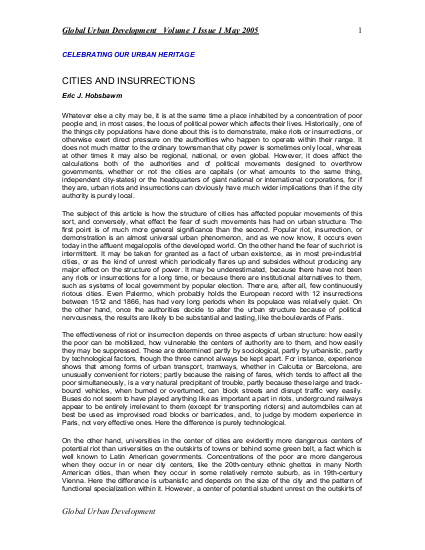
Whatever else a city may be, it is at the same time a place inhabited by a concentration of poor people and, in most cases, the locus of political power which affects their lives. Historically, one of the things city populations have done about this is to demonstrate, make riots or insurrections, or otherwise exert direct pressure on the authorities who happen to operate within their range. It does not much matter to the ordinary townsman that city power is sometimes only local, whereas at other times it may also be regional, national, or even global. However, it does affect the calculations both of the authorities and of political movements designed to overthrow governments, whether or not the cities are capitals (or what amounts to the same thing, independent city-states) or the headquarters of giant national or international corporations, for if they are, urban riots and insurrections can obviously have much wider implications than if the city authority is purely local. The subject of this article is how the structure of cities has affected popular movements of this sort, and conversely, what effect the fear of such movements has had on urban structure. The first point is of much more general significance than the second. Popular riot, insurrection, or demonstration is an almost universal urban phenomenon, and as we now know, it occurs even today in the affluent megalopolis of the developed world. On the other hand the fear of such riot is intermittent. It may be taken for granted as a fact of urban existence, as in most pre-industrial cities, or as the kind of unrest which periodically flares up and subsides without producing any major effect on the structure of power. It may be underestimated, because there have not been any riots or insurrections for a long time, or because there are institutional alternatives to them, such as systems of local government by popular election. There are, after all, few continuously riotous cities. Even Palermo, which probably holds the European record with 12 insurrections between 1512 and 1866, has had very long periods when its populace was relatively quiet. On the other hand, once the authorities decide to alter the urban structure because of political nervousness, the results are likely to be substantial and lasting, like the boulevards of Paris.
Resource collections
- UN Habitat - Urban Response Collection
- Urban Response - Urban Crisis Preparedness and Risk Reduction
- Urban Response Collection - Community Engagement and Social Cohesion
- Urban Response Collection - Economic Recovery
- Urban Response Collection - Environment and Climate Change
- Urban Response Collection - Housing, Land and Property
- Urban Response Collection - Urban Crisis Response, Recovery and Reconstruction
- Urban Response Collection - Urban Resilience